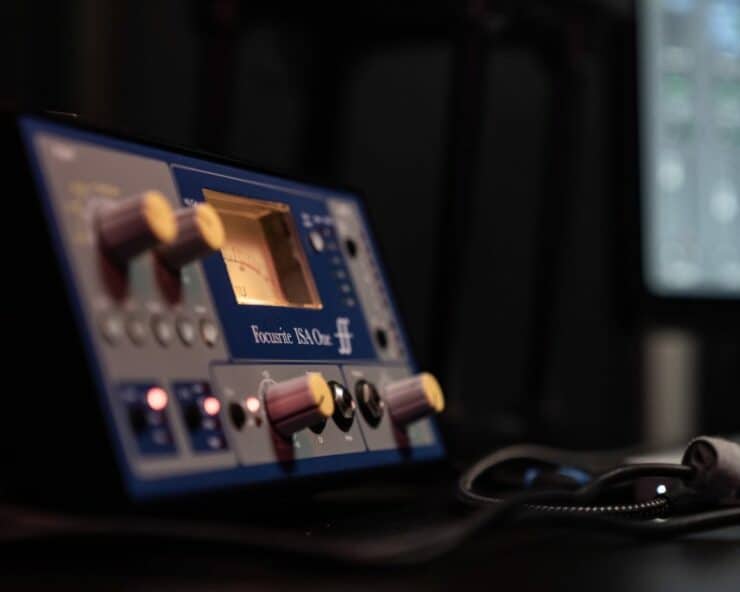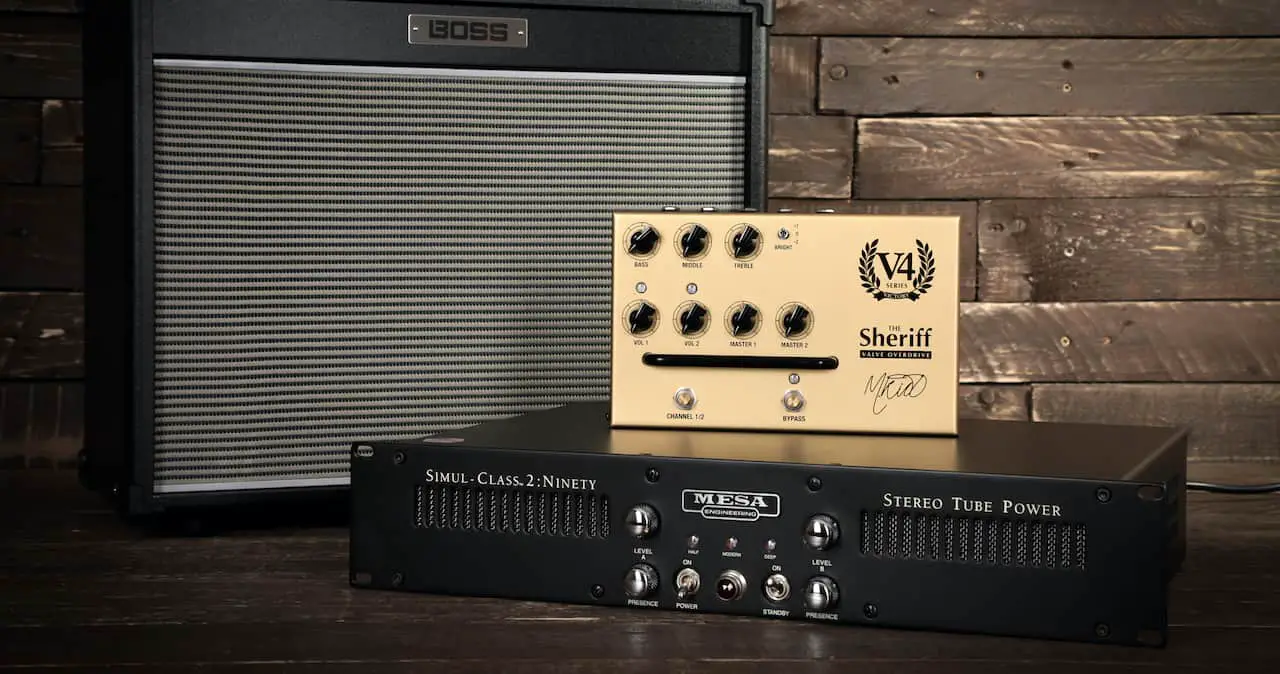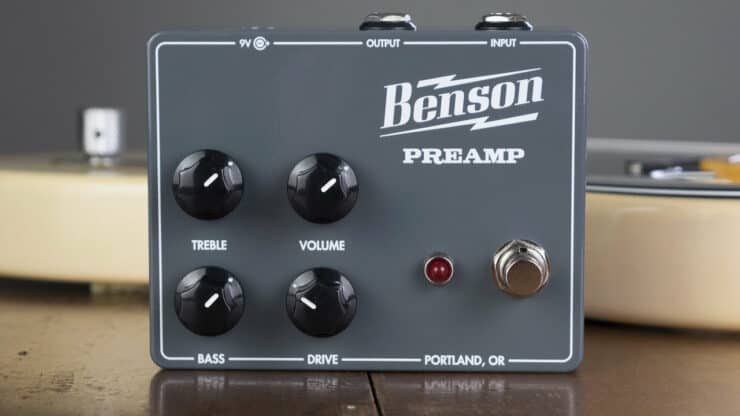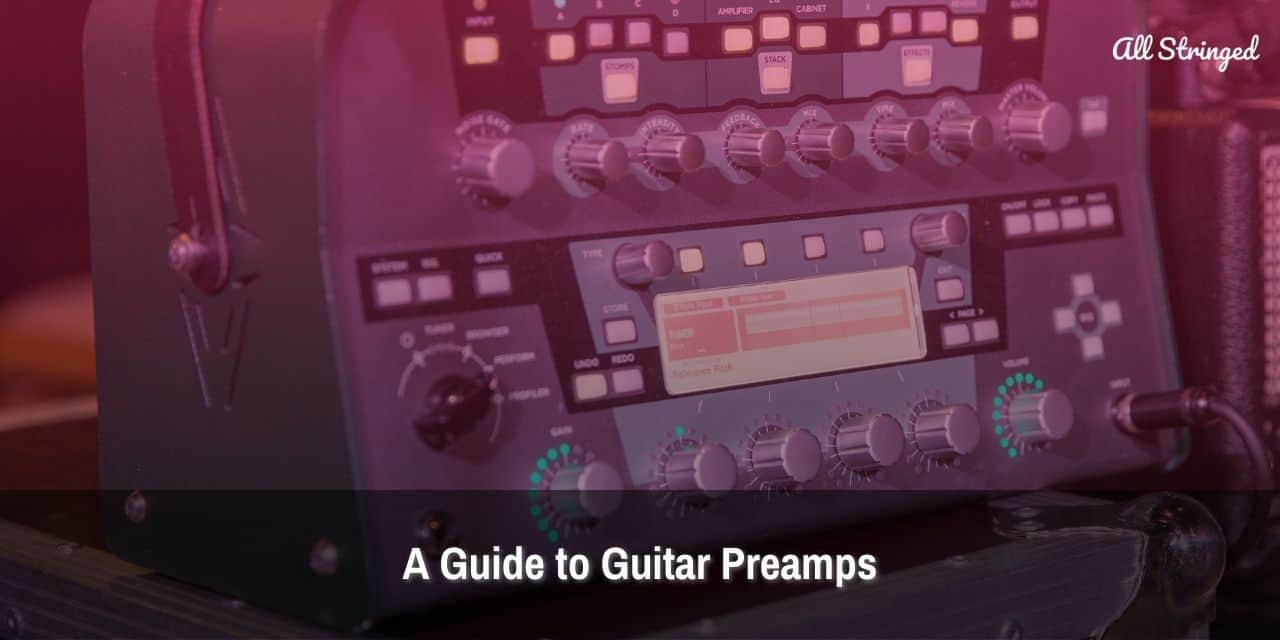Are you looking to take your guitar playing to the next level? A preamp can help you unlock the potential of your guitar, but it can be confusing to understand. This guide will take you through the basics of preamps, types, and usage to help you make the most of your instrument. Whether you’re a beginner or an experienced guitarist, you’ll learn something new in this article, so read on and discover how to unlock your guitar’s potential!
What is a preamp?
A preamp is largely responsible for giving your amp its core sound. In essence, this is the section that’ll enable you to shape up your amp’s overall voice and character. Essentially, it’ll encompass the EQ controls that you will normally find on your amp’s front panel such as bass, treble, and middle.

Unless you’re using multiple guitar pedals in the front of the amp, the first thing that your guitar’s output signal interacts with will be your amp’s preamp section. This is because the first stage of almost any amp will be the preamp. This comes before the power amp. Some of the amps feature what is known as an “effects loop”. This is an input and output section between these two stages.
ALSO READ: 15 Best Guitar Preamps
What does a preamp do?
The most significant function of a preamp will be to boost your guitar’s output signal up to the line level. A pure guitar signal usually sounds weak and anemic, something that is evident when you’re plugging a guitar directly into something like an audio interface or PA system. Therefore, a preamp will be able to raise a guitar’s signal to the audible volume. It’ll add compression and ensure you’re getting a more dynamically consistent sound.
If you have a valve amp, it is the tubes in the preamp section that generally cause compression. Most valve amp manufacturers prefer fitting their preamps with 12AX7 (also known as ECC83) tubes. These have become somewhat of an industry standard. 12AX7s are known for reacting particularly well to electric guitars, which causes a musical-sounding break when the preamp is turned up.
How does a preamp pedal work?
A preamp pedal works by mimicking the preamp section of the amp. Many amplifier preamp sections use tubes or valves to add compression for a more consistent tone. Preamp pedals differ, as they’ll generally use solid-state circuitry instead. This will allow the pedals to be more reliable and rugged when compared to the amp sections they emulate.
That isn’t to imply that all preamp pedals use solid-state innards, as some high-end options do come with tubes. With a tube preamp pedal, you will be rewarded with a more authentic sounding tone, but the brittle glass valves eventually have to be replaced.
In terms of features, you will find many traditional controls you’ll normally find on a regular amp, such as clean and overdrive channels, an equalizer section, and master volume controls.
Different types of preamps
The first important distinction that you should make among the different types of preamps available will be an aesthetic one. Decide whether they are designed for adding color or delivering a transparent signal. You’ll normally find both types of preamps in most studios to meet a wide range of recording needs. A color preamp is capable of adding more body and character to a thin voice or instrument, while a transparent preamp reproduces the original instrument or vocal sound as accurately as possible.
Preamps that add color
Certain preamps come designed to enrich the sound or timbre of the signal. This can be quite useful if the signal sounds dry and thin. Adding more color with a preamp can make the recordings sound more intimate or over the top or even larger than life depending on how you’re applying color. Audio engineers who prefer color in their preamps prefer adhering to the philosophy that whatever helps in achieving the sound you’re after will be employed in the process. Usually, people in this camp prefer using tube and solid-state preamps with transformer-coupled designs.
Transparent preamps
There are some audiophiles and engineers who go for a pure, transparent philosophy of sound. They argue that the goal will be to produce the sound of the instruments and voices as clearly as possible without having to alter the fundamental tone or timbre along the way. Audio engineers and producers prefer using preamps that provide as transparent a signal reproduction as possible. They also prefer transformer-less solid-state preamps. Recording engineers who work with classical and jazz performances that are focused on acoustic instruments usually seek a more transparent signal.
Although some engineers and producers prefer transparency, others tend to rely on preamps to be a part of the fundamental sound. Transparent doesn’t necessarily mean sterile. Further, “color” doesn’t necessarily mean doing away with the instruments, sounds, and voices in your arsenal. Both of these philosophies can be easily applied to recorded music for achieving results. In fact, many audio engineers and producers prefer using both types of preamps, choosing one or the other as the situation and music dictate.
RECOMMENDED: The Ultimate Guide to Guitar Amps
When considering how preamps affect the sound, it’ll be important to consider that any electronic signal path always adds, changes, or takes away something in the process. The only true acoustic reproduction will be done by your ears. Once you’re factoring in the impact of mics, cables, compressors, equalizers, preamps, loudspeakers, and analog to digital converters, the end signal will be affected. The ultimate decision will be what sounds pleasing to your ears.
Circuit design
Preamp types can be categorized by the circuit design as well. The first main distinction will be tube vs. solid-state preamps. When you’re hearing or reading discussions regarding preamps and their sounds, this distinction will be at the forefront.
Tube preamps
Tube preamps make use of thermionic tubes (also known as vacuum tubes or valves) for creating gain. Most tube amps color your sound significantly. Tube preamps are known to add deep bass, warm presence, and open and airy highs in the midrange. Often, tube preamps will be described as “fat” or “warm” sounding.
To better understand what it means, it’ll be important to look at how tubes function. As there’s an increase in the signal level, the tube will produce mild distortion. This will, in turn, produce the body and depth that the warmth is meant to describe. As the distortion is produced generally and in specific measured amounts, it’ll be pleasing to the ear. If you go deeper, the distortion will take the form of second or even-order harmonics. This is considered to be more musical. Here is why –
Harmonics are component pitches of fundamental tone that produce sound at whole number multiples of the fundamental. Musically, the second-order harmonic will form the interval of a perfect octave. The octave will reinforce the fundamental tone, which is very similar to the effect called doubling. This is where the word “fat” comes in, as octave doubling results in a broader sound that has more depth. Beefier will be another word that can be used for describing tube preamps by producers and engineers.
Even-order harmonics are capable of producing pleasing distortion, as they do not produce the dissonant pulsing caused by odd-order harmonics. The addition of even-order distortion through tubes will equal better color. This effect is commonly referred to as harmonic distortion.
Tube preamps are capable of providing color through the natural compression characteristics that are provided by tube circuit designs. When you look at the waveforms, the curve at the top of the wave will be more compressed as the gain is applied gradually. The human ear deems natural compression to be pleasing. Natural tube compression can be quite subtle, but many audio engineers and producers pay top dollar for high-quality tube compression on the final mix. It is indeed the “audio glue” that brings the mix together and gives it a complete, professional sound.
Yet another natural function of tubes will be to act as low-pass filters, which smoothens distortion in the high end of the spectrum and can reduce high-frequency content. It could be desirable or undesirable depending on the sonic goals. For instance, it is desirable for warmer vocals and undesirable for percussion, where attack information will be essential.

Solid-state preamps
One of the results of evolving technology is the development of transistors that help achieve a gain in solid-state preamps. Transistors are much more efficient in this regard, as they create gain with less heat. Transistors operate more consistently as gain increases, which maintains low distortion up to their maximum levels. They perform optimally and offer minimal distortion at high levels of gain. The transparency of solid-state devices will largely be due to their capability to accept significantly higher gain levels without actually distorting.
While tube amps have their user base centered around their unique musicality, solid-state amps, on the other hand, have their benefits as well. Known for its unique solid signature, solid-state preamps are designed by Rupert Neve, who is considered to be the grandfather of professional audio. Neve’s designs are found in some of the most popular recording studios around the world.
Digital preamps
With a few similarities to modeling preamps, digital preamps convert analog signals to digital signals. Moreover, they also add their sonic signature in the processing before it is output to a DAW. This will allow the users to process the signals with a dedicated preamp. You’ll be able to bypass the built-in process of conversion that is supplied by the interface’s typically inferior converters. Some digital preamps also come with a digital output sound card that you can install on the user’s computer. Others will come with the processing and conversion that are built into the preamps.
Technically, these preamps can be considered to be digital interfaces, as they’ll effectively convert an analog signal to a digital signal for usage in a DAW. The units are designed primarily as preamps, and the digital conversion of the audio signal will be a convenient byproduct of the primary preamp function.
Instrument-specific preamps
The preamp principles discussed until now are based on using a mic as the first component to capture sound. Most preamps that fall under these categories are designed to take the input signals from a mic and process the signal internally.
However, there is another category of preamp that’ll be important while also being different from the types discussed previously. There are many types of instrument-specific preamps available in the market today. These preamps come with circuitry designed for optimizing the tone of a specific type of instrument like an acoustic guitar, electric guitar, or bass. Many of these units can be classified as Direct Injection (DI) boxes that allow the connection of guitars and basses to mixers and recorders directly.
Instrument-specific preamps are designed for, taking into account the unique impedance requirements and voicing of the instruments that they are designed for. In numerous instances, instrument-specific effects can be included in this type of preamp too.

Benefits of using a guitar preamp
#1. Additional tone shaping
If you cannot dial the tones that you have in your head into the amp, a preamp medal could give you the needed tools for achieving these sounds without needing to buy a whole amp. You might be able to obtain a wide range of tones that your amp wouldn’t be able to output normally.
If you need a completely different EQ to your amp’s usual setting, you can turn on the pedal for those songs that you want tweaked sounds.
#2. Improved sound consistency
By keeping the sound on a pedalboard, you can achieve a more consistent sound from venue to venue. Your tone will be much more familiar regardless of what you are plugging into.
#3. Improved recording consistency
By recording directly with a preamp pedal, you’ll be able to bypass the additional coloration that an amp would have added to the tone. You will only be recording the tone of the guitar’s pickups and the pedal itself. This will make it easier for you to mix the recordings later on.
#4. A tube amp sound without a tube amp
You’ll be able to enjoy the warmth and response of a tube amp while making use of a lighter and cheaper solid-state amp or similar. Just add a tube preamp pedal to upgrade the sound of the gear.
#5. Save your back
Turn your pedalboard into a standalone unit by sending the signals directly to the front of the house. You can experience the sound and benefits of the traditional amp without needing to lug around bulky gear to the gig or recording studio.
#6. Switch between multiple instruments
When you’re switching from one guitar to the other, the EQ and levels will have to be adjusted to compensate. No one has the time for that during a set.
Keeping a preamp pedal ready to go with the next instrument’s settings can save a lot of time tweaking controls. You can just plug in the other guitar and then switch on the preamp pedal, and you’ll be good to go.
#7. An amazing backup option for gigging
You might be totally happy with your amp but be worried about its reliability. What if an issue arises one night during a live gig? In this situation, a preamp will be a great “get out of jail free card” as you can run it directly into the PA and continue with the gig.
It will be an amazing option for gigs where you’re having to rely on other people’s equipment. If you cannot get the sound that you are after from another amp, then a preamp pedal can save the day.
#8. Cost savings
Except for some real boutique options, the majority of preamp pedals are less expensive compared to the amps that they’ll likely be replacing. Couple it with the reliability of these pedals and not only will you have to pay less money from the start, but you will also end up saving money eventually.
#9. Use other players’ amps
If you are using other players’ amps when playing live, they might get a bit annoyed when you mess around with the settings. By using a pedal, you’ll be able to bypass the preamp section and negate the need of fiddling with the EQ settings.
#10. Additional features
Many preamp pedals come with features that your amp may not already have. For instance, cabinet simulators, an XLR out, a headphone out, additional EQ parameters, tubes, and more. Therefore, they can add a lot of extra versatility to the rig.
Disadvantages of using guitar preamps
#1. Lack of realism
The main downside that you’ll notice according to the guitarists is that many of them believe that preamp pedals tend to lack the authenticity of a genuine amp. However, these pedals have certainly come a long way lately, so this is only an issue that was prevalent in older pedals.
Meanwhile, modern preamp pedals, especially the ones with cabinet emulation, have been lauded for their accurate feel and sound.
#2. No speakers
Unlike a traditional guitar setup that makes use of an amp, a rig that features a preamp pedal will definitely lack the speakers needed for filling a venue with your melodious tones.
This essentially means that as a live musical, you’ll largely be reliant on the venue having a perfectly compatible PA system with your rig. However, it is quite unlikely that you’ll come across a venue where this will not be the case.
Where should you place a guitar preamp in the signal chain?
It is widely accepted that a preamp pedal needs to be placed at or near the start of the signal chain. To create the sound of a traditional amp, it needs to be placed before the power amp or cabinet simulator pedals if you’ve been using those.
It is normal to place the tuner pedal before the preamp pedal and have all the other effects afterward. When it comes to the pedals, there aren’t any concrete rules. You should feel free to experiment with the placement to see what works best for you.
Further, it’ll also be worth noting that if your amp has an effects loop, it’ll be common to use the preamp pedal here. Doing so will bypass the preamp section of the amp and go directly to the power amp stage. This will give you the benefit of ensuring that the pedal is operating as cleanly as possible.
FAQs
What is a guitar preamp?
A guitar preamp is a device that boosts the signal from a guitar’s pickups, allowing for greater control over the sound before it is sent to an amplifier. Preamps add additional tone shaping capabilities and allow players to adjust the sound of their guitar before it is amplified.
What are the benefits of using a guitar preamp?
A guitar preamp can add clarity, depth, and warmth to the sound of a guitar, and can also provide additional tone-shaping capabilities. Preamps are typically used in studio recording, as they can help achieve a more polished sound.
What types of preamps are available for guitar?
There are several types of preamps available for guitar, including standalone preamps, multi-effects processors, and preamp pedals. Standalone preamps are designed to provide a clean boost to the signal, while multi-effects processors and preamp pedals offer a wide range of sounds and effects. Each type of preamp offers its own unique features and benefits, so it’s important to consider which type of preamp is best for your needs.




